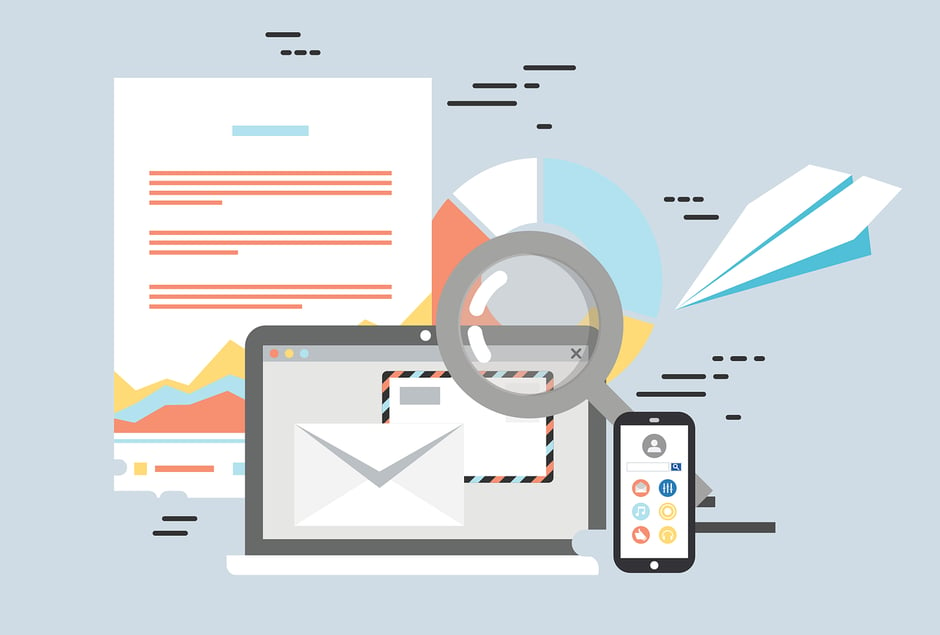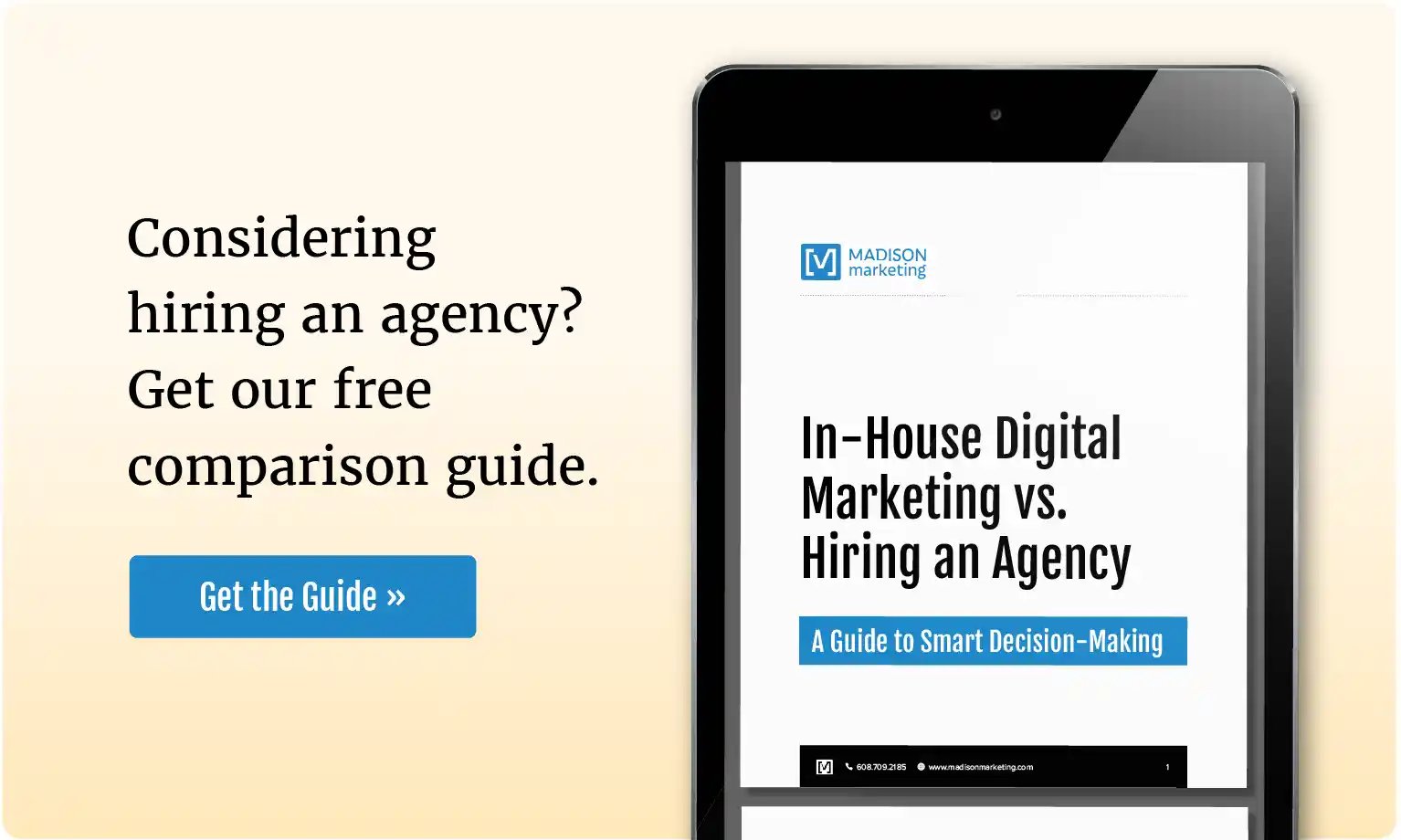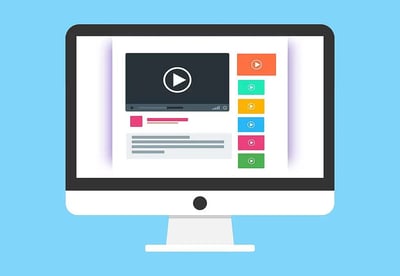Email marketing is alive and well.
- "Email has an average ROI of $36 for every $1 spent." (HubSpot)
- "Analysts expect the number of email users to grow by 2.5% in both 2024 and 2025." (HubSpot)
- In a survey of B2B marketers by the Content Marketing Institute, 44% said email was an effective content distribution strategy.
Email marketing has proven itself to have lasting power as a communication channel that works. But the challenges of email marketing, from dodging spam folders to earning opens and actions, are still plaguing businesses today.
That’s why I compiled this massive list of tips for overcoming these challenges and improving performance.
TABLE OF CONTENTS
1. Optimize your sender information
3. Be honest & follow the rules: GDPR, CAN-SPAM, etc.
5. Optimize the user experience
1. Optimize your sender information
A few quick tips on the technical side of sending:
- Use the name of an actual person from your company as the sender. HubSpot found that recipients trust the names of real people more than generic senders like the name of your company. Plus, this complies with the FTC’s CAN-SPAM regulations, as explained by Content Marketing Institute.
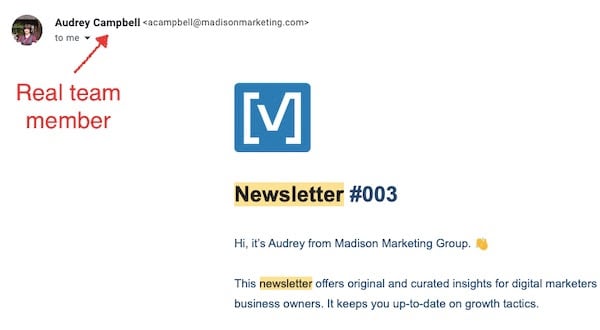
- Use your company domain for permission-based email marketing. The Content Marketing Institute astutely points out that sending emails from a free email address (like a personal Gmail account) looks “unprofessional and spammy.”
It also leaves you at the mercy of the third-party email client, who could shut your email down if they got complaints. While most companies send from their company domains, small companies or those very new to email marketing might not have this on their radar. - Use a separate email domain for sending cold emails, specifically. Using your company domain to send unsolicited marketing messages to those who don’t know you and haven’t expressed a desire to receive emails can put your sending reputation in danger of unsubscribes and spam reports.
Instead, set up a separate domain specifically for sending cold emails. This can be a variation on your company domain. Keep your primary company domain only for sending emails to those expecting it.
2. Optimize your email copy
Email copy—the written content of your email—is the substance of your message. The copy does most or all of the work of enticing your recipients to open and consume your message.
To respect that attention and accomplish the goal of your email, your copy has to be tactfully written.
Use these strategies to write copy that earns you opens and engagement in an otherwise noisy inbox.
Optimize subject lines
- Make it less than 50 characters. This ensures recipients can easily read the whole thing and it doesn’t get cut off (HubSpot). 99 Firms goes as far as recommending that you limit yourself to 3 or 4 words, but best practices here are squishy at best.

Backlinko’s scrupulously short headlines mimic a personal email; Source: Backlinko
- Avoid Spam words. Avoid words like (“save, cash, and quote”) that might send your email to a spam folder (HubSpot).
 An unfortunate word choice landed this email in my spam folder; Source: The New York Times
An unfortunate word choice landed this email in my spam folder; Source: The New York Times
- Elicit excitement. Excite the recipient about the email (HubSpot). 99 Firms also recommends using action verbs.
 Who doesn’t want their products to appear in front of their target audience?; Source: SEO Powersuite
Who doesn’t want their products to appear in front of their target audience?; Source: SEO Powersuite
- Communicate urgency or timeliness. If applicable, tap into recipients’ fear of missing out (FOMO) by indicating that the information or offer is timely, will expire soon, and/or that an action needs to be taken soon (HubSpot).
Since the recipient opted in to get updates and offers like these, HubSpot notes that it’s good to evoke why they subscribed in the first place, however, these types of headlines should be used sparingly.
 Source: Udemy
Source: Udemy
- Personalize. Use recipients’ names or locations, if applicable (HubSpot).
 Source: PayPal
Source: PayPal
- Elicit curiosity. Write an (on-brand) headline that acts like a teaser, communicating that recipients will be rewarded with something interesting if they open the email (HubSpot).
 '
'
Source: Content Marketing Institute
- Communicate your value proposition. Make sure your headline communicates what’s in it for the recipient if they open your email (HubSpot).
 Source: Hootsuite
Source: Hootsuite
- Name drop. When relevant, including a recognizable name in your subject line, such as an industry expert, can be an incentive to open the email (HubSpot).

Both a name drop and an unfinished story; Source: The Content Marketing Institute
- Tell Stories. When appropriate, hook recipients with a good opening to a good story that they have to open the email to finish (HubSpot).
- Make people feel special. Communicate exclusivity (when appropriate) and identify the participant as part of a select group (HubSpot).

Source: CoSchedule
- Use data. Not every email uses numbers in the subject line, so that will automatically help you stand out as well as making your offer clearer and “setting expectations.” (HubSpot).
 Source: Airfare Watchdog
Source: Airfare Watchdog
- Communicate clearly. Tell recipients what’s inside your email, if you’re delivering something, like a downloadable resource (HubSpot). 99 Firms also emphasizes truthfulness: if you make a promise in the subject line, be sure you deliver in the email.
 Source: Google Search Console
Source: Google Search Console
- Ask a question. Hook recipients with a compelling, relevant question they want the answer to (which is inside the email or its offer) (HubSpot).
 Source: Content Marketing Institute
Source: Content Marketing Institute
- Avoid using too many exclamation points or ALL CAPS!!!!! As HubSpot points out, this is the written equivalent of yelling, and recipients don’t like that, according to research by Radicati group (via HubSpot).
- Keep it conversational. 99 Firms points out that email subject lines are often scrutinized by spam filters for tells that imply that the email is spam.
This includes spam words, “false or suspicious” subject lines (according to Content Marketing Institute), and possibly even the length, according to Backlinko (shorter is better; more words = more opportunities for one of them to trip the spam filter).
As a result, writing a subject line that feels like you’re sending a single email to someone you know is generally better than something that feels like marketing.
Customize preview text
- Take the opportunity to position in your preview text. Preview text is the preview of the first few lines of an email that follows the subject line in your inbox. According to Litmus, if left to its own devices, your recipient’s email client will pull text from the email to populate this area.

Preview text that was likely too short, or not customized at all; Source: Ebay
Depending on what software you use to write and send your marketing emails, you may be able to customize it, however. In software like HubSpot, you can type your preview text into a specific field, for example.
Or, if you don’t have this luxury, you may be able to code it. This gives you more space to persuade the recipient to open your email.
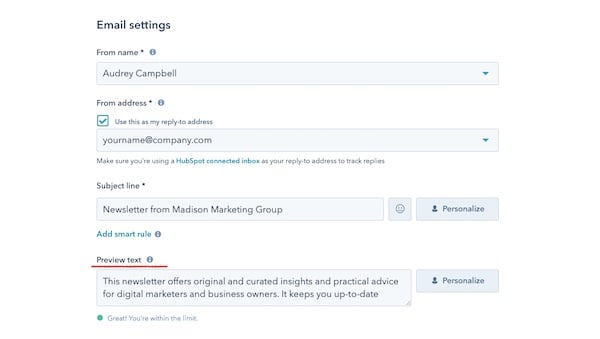 You can customize your preview text in HubSpot’s email tool; Source: HubSpot
You can customize your preview text in HubSpot’s email tool; Source: HubSpot
- Entice the reader. Backlinko recommends reworking (if necessary) the first few lines of your email and using that for the preview text so it’s extra compelling.
Think of this as the subheading of your email: a great place to provide additional details, and pique your subscribers’ curiosity, as ActiveCampaign points out. He recommends using up to 3 of the following curiosity inspiring tactics:
“1) Ask a curiosity-inducing question; 2) start a sequence of events, but don’t finish (e.g. an unfinished story); 3) violate expectations; or 4) imply that you have information they don’t; 5) imply that they used to know something that they’ve since forgotten.”

- Don’t repeat information from the subject line (99 Firms).
 Source: Hootsuite
Source: Hootsuite
- Make your main point (99 Firms). As ActiveCampaign points out, it’s best to do this early in the description, to ensure that your primary message is delivered before the text cuts off in mobile clients.
- Use 40-130 characters. Depending on the email client your recipients use and whether they’re viewing your email on a mobile device or desktop, the preview text will typically cut off somewhere between 30 and 130 characters, ActiveCampaign notes. Mobile devices often cut text off at 30-55 characters.
He adds it’s best to shoot for somewhere in the middle of this range—90 is Litmus’ recommendation—because if you make your description too short, the email client may pull text in from the body of your email to add characters. But, there's a trick you can use to prevent this from happening. - Include a clear next action. Tell the reader what you want them to do next (99 Firms).
 Source: SEO Powersuite
Source: SEO Powersuite
- Preview the email before sending. Make sure your preview text doesn’t cut off in an awkward place by previewing it before sending, Litmus warns. In HubSpot, for example, you can preview your email on many simulated clients and devices.
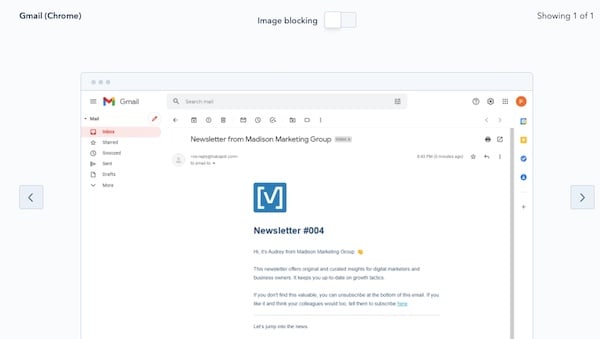
Preview text that was likely too short, or not customized at all; Source: Ebay
Optimize the email body copy
- Don’t make it too long. Lots of copy in an email can be a trigger for spam filters (HubSpot). Be concise and cut the fluff.
- Communicate urgency, when appropriate. As with headlines, harnessing the power of FOMO can help you improve conversion. 99 Firms notes some ways to achieve this, including using repetition, indicating a clear deadline, and using urgent language.
- Make it look like a regular correspondence. HubSpot says recipients prefer marketing emails that look more like a regular email. Avoid using different font sizes, styles, unusual colors, or invisible text (e.g. white text on a white background) to avoid putting readers off or getting labelled as spam.
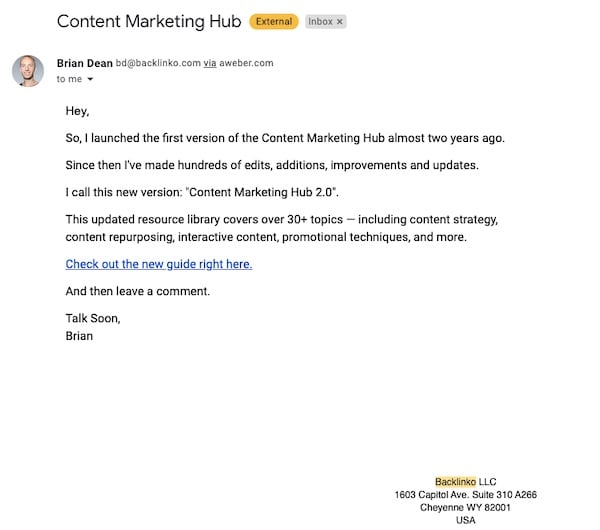
A short marketing email that feels like a colleague sent it; Source: Backlinko
Optimize CTAs
- Make sure you direct users to one clear CTA button. This helps people who are scanning the email notice your offer.
In the Backlinko example from the previous section, you’ll notice that there is only one hyperlinked CTA that jumps off the page (although there is no button). They also fit in a secondary CTA, “leave a comment,” but it doesn’t compete. - Describe your offer in the CTA button’s alt text. This way, if your recipients’ email client blocks images, they still know where to click and why (HubSpot).
- Link to your offer in more than one place. Include a link to your offer in more than one area of the email to give recipients more opportunities to click on it (HubSpot).
- Put it above the fold. It’s best to put your CTA near the top of your email, so people don’t have to scroll to see it (HubSpot).
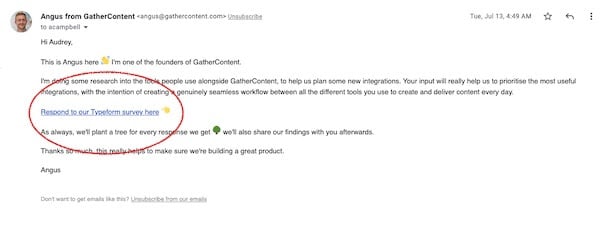
Source: Typeform - Make images clickable. Add links to your offer in the images of your email to give people more opportunities to click (HubSpot)
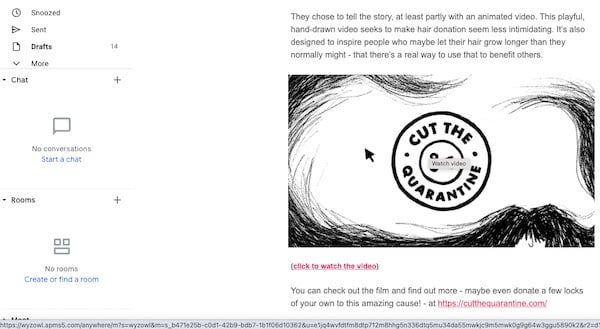
Source: Wyzowl
3. Be honest and follow the rules: GDPR, CAN-SPAM, etc.
While it’s ultimately up to company filters, email service providers, and human recipients whether you stay out of the spam folder, there are measures you can take to avoid getting flagged as spam, including ones we have discussed already—here are some more.
Don’t play hide the unsub button
- Make it easy to unsubscribe. Follow Backlinko’s example and put your unsubscribe button in an easy-to-see place to avoid frustrating people. If you don’t, they may hit the spam button instead.
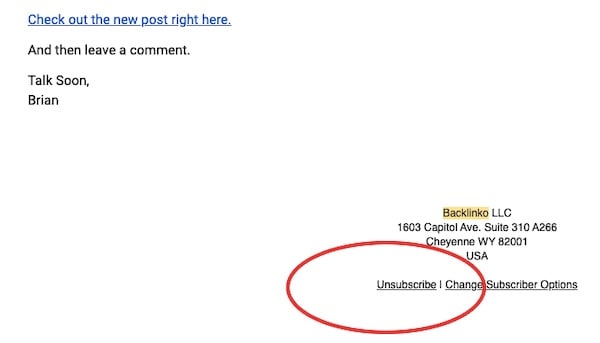 Source: Backlinko
Source: Backlinko
- Don’t send lots of emails. No one likes to have their email flooded with offers. Backlinko recommends keeping it down to one per week.
- Ask subscribers to double opt in. After someone has subscribed to your email list, Content Marketing Institute recommends sending another email to confirm registration. This makes your emails less likely to end up in spam and more likely to get delivered since it helps ensure that only willing subscribers stay in your list.
- Follow the 80/20 rule. As with social media, it’s smart to send subscribers 80% helpful or entertaining content, and 20% promotional (Backlinko).
Follow the rules
- Comply with any anti-spam laws in your country. For example, if your subscribers live in Europe, Canada, or the US, Content Marketing Institute recommends checking out GDPR, CASL, and FTC’s CAN-SPAM ACT laws. A few U.S. requirements include:
- Swiftly removing those who have unsubscribed from your list (Content Marketing Institute).
- Including your business’ postal address in your email (current street address, USPS P.O. box, private mailbox) (Content Marketing Institute).
- Give recipients a way to unsubscribe in every email (HubSpot).
- Don’t use “no-reply” or other sender names that don’t give people the option to unsubscribe (HubSpot).
- Don’t move email addresses from one list to another (HubSpot).
- Provide accurate sender information that “accurately reflects who you are” (HubSpot).
- When asking people to fill out a form with their contact info, don’t pre-check the box that allows you to send them marketing materials. According to HubSpot, this is a GDPR violation.
Since this is not legal advice, I recommend reading about the FTC’s exact guidelines, and learning more about GDPR.
- Don’t buy email addresses. HubSpot notes buying or renting email lists can be against the rules of your email service provider. She also mentions it violates GDPR, Europe’s anti-spam law, and that it’s a poor tactic anyway since people who never opted in are unlikely to be interested in your business.
- Don’t scrape sites. Another shady tactic is scraping websites for email addresses. This is a CAN-SPAM ACT violation, according to HubSpot.
- Don’t use your outreach emails as a custom audience for retargeting on Facebook. The Content Marketing Institute notes that now Facebook only allows you to do this if you have the express permission of individuals to use emails to target them on Facebook.
Instead, she recommends setting up a landing page for your outreach email and installing a Facebook pixel there so you can retarget them with Facebook ads later.
Avoid tripping spam filters
- Don’t use a new domain to send lots of emails. Content Marketing Institute notes that this looks suspicious to a spam filter.
If you set up a new website with a new name (e.g. “company.” com) which you then use for your work email (e.g. “johnd@company.com”), warm-up that email address first by sending a few emails to members of your organization.
The Content Marketing Institute recommends asking your colleagues to reply and resisting the urge to set up more than one email per new domain, at first. This builds up your reputation.
She also recommends using an email address with a domain that is 3-4 months old for email marketing. - Ask subscribers to add you to their contacts list. This signals that recipients trust you and makes you less likely to land in the spam folder (Content Marketing Institute).

How to add a contact in Gmail; Source: Backlinko
- Always provide value. Write great emails that encourage engagement. Lots of low-engagement emails over time can send you to the promotions or “junk folders” (Content Marketing Institute).
On a similar note, HubSpot warns against using so many keywords in emails that they sound artificial, which harms user experience. Instead, she recommends writing natural, engaging copy. - Don’t use a lot of images. Some spam folders may flag image-heavy emails as spam (Content Marketing Institute).
- Don’t include an attachment. This may cause your email to be flagged as spam, cause your email to bounce, or make it take too long to load after the recipient clicks on it (Content Marketing Institute).
- Don’t use a blacklisted IP address. HubSpot notes that your IP address (your domain’s ID number and location information, essentially) may have a bad reputation, enough to make it difficult for emails that use this address (e.g. johnd@“company”.com) to escape the spam filter.
As a result, staying off the blacklist and knowing whether you’re on one is important for email deliverability. - Edit. Misspellings can trigger spam filters, so be sure to carefully copy-edit your work (HubSpot).
- Don’t embed videos or use javascript. According to HubSpot, “most email clients don't allow the ability to view rich media like Flash or video embeds. Instead, use an image of your video player (with a play button) that links to the rich media on a website page.”
- Don’t embed forms. Similarly, HubSpot notes that forms pose “security risks” and are generally “not supported” by email clients. Instead, she recommends using a CTA button to take a recipient to a landing page.
- Don’t use URL shorteners in the copy. This is a spam trigger (Content Marketing Institute).
- “Don’t use HTML in the copy.” This is a spam trigger (Content Marketing Institute), and some email clients don’t support it, according to Mailchimp. In general, they recommend maintaining a ratio of 80% text to 20% images, since image-heavy emails are more likely to get 86ed.
- Check your spam score. A spam score tool can test an email or subject line for spam triggers and give you pointers on how you can improve. Here are some Content Marketing Institute recommends:
- Ominisend Subject Line Tester: for testing subject lines
- Mail Tester: for testing emails
- Inbox Email Tester: for testing emails
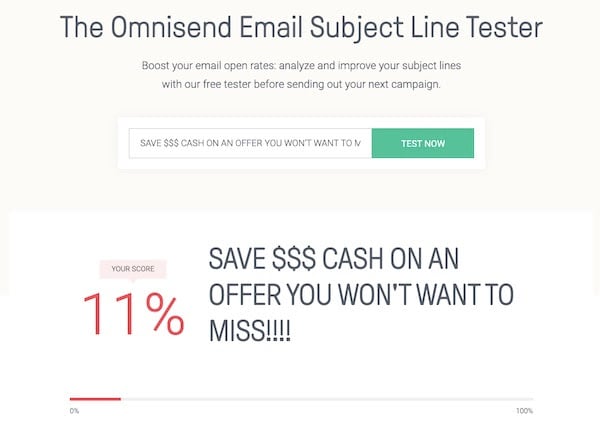
Source: Omnisend Subject Line Tester
4. Clean your list
For the sake of your sender reputation and KPIs like bounce rate and click-through rate, it’s critical to keep a clean email list, according to HubSpot. Here are some tips for maintaining great list hygiene.
- Get rid of addresses that haven’t opened your emails. Both Backlinko and Content Marketing Institute recommend getting rid of addresses that haven’t engaged with you in more than 4 months.
- Email them less before culling addresses. Content Marketing Institute recommends lowering your frequency incrementally before removing addresses from your list. Maybe they aren’t engaging because you’re emailing them too much.
He suggests that after 30 days you go to mid-frequency, 60 days—low frequency, then remove them if they haven’t opened an email from you after 120 days. - Send re-engagement emails. Before cutting emails from your list, Drip recommends sending them emails that tell them that they’re on the razor’s edge of getting cut and give them the opportunity to stay on your list. She recommends keeping them conversational and providing a clear CTA that tells them what they need to do.
- Don’t email addresses that have hard bounced. According to HubSpot, emails that have hard bounced will never be successfully delivered, and delivery rates are one of the factors internet service providers consider when flagging emails as spam.
Drip notes that “hard bounces” are usually due to factors like misspelled addresses or nonexistent domains, while soft bounces tend to be due to factors like an inbox being too full, a down server, or your email being too large for their inbox.
5. Optimize user experience
Ensure your emails are easy to read on any device, a manageable size, and load quickly.
- Use a big font: 15pt or bigger. It helps ensure it’s easy to read on mobile (Backlinko).
- Keep the design simple. If you’re writing a newsletter, err on the side of making it look like a personal email, Backlinko recommends, going on to say that design elements distract from your content.
Plus, as HubSpot notes, recipients generally prefer emails with simple, familiar text (no unusual font colors, sizes, or styles).
As we discussed in other parts of this post, it’s also best not to use too many images (and avoid background images altogether, HubSpot says) embed forms or videos, or use javascript because either email clients don’t support them or they trip spam filters (or both). Bottom line: simple is best. - Reduce image file size. This can head off slow mobile download speeds (HubSpot).
- Make CTA buttons larger than 45-57 pixels large so they are easier to click. HubSpot notes that the average adult index finger is 1.6 - 2 cm, citing an MIT study.
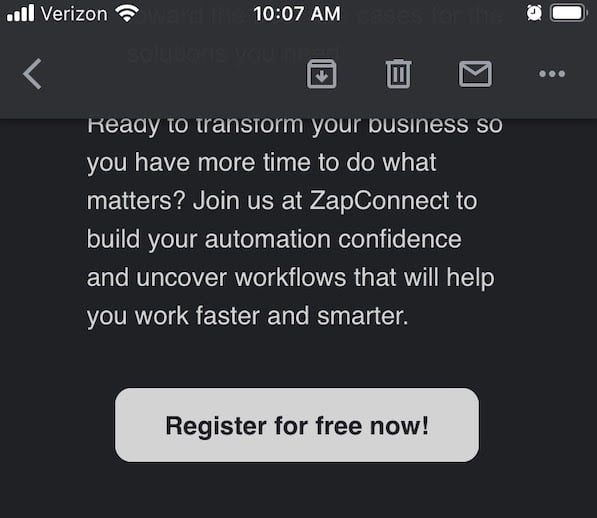
A comfortably sized CTA; Source: Zapier
- Use a responsive template. Responsive templates spring to the size of whatever screen they are viewed on, helping ensure a great user experience no matter what device the recipient is using (HubSpot).
- Use alt text. Ensure every image in your email has alt text. Alt text is a description of the image for visually impaired people to provide context (e.g. “business woman in grey suit typing on laptop”). It’s also what the recipient will see if the image fails to render on their email client.
- Advertise a video. 99 Firms suggests adding a video thumbnail with a play button icon that links to a video. According to a recent Vidyard study, participants reacted more positively to video emails than text only, and remembered the contents better.
6. Target the right people, the right way, with the right content
Segmentation can increase the likelihood you’ll send subscribers relevant content that resonates with them, while personalization tailors mass emails to each recipient using data like their name, location, or industry.
- Segment your list. Try segmenting emails by useful categories like interests, location, and activity, 99 Firms recommends. In addition, The Content Marketing Institute recommends segmenting by previous interactions with your brand.
For example, Neil Patel suggests segmenting by engagement, such as whether they’ve opened your previous emails, then putting the unresponsive people in a re-engagement campaign.
He also suggests segmenting by funnel (or buyer’s journey) stage to provide tailored messaging. Here are 30 helpful ways to segment your list. Bottom line: only send people relevant emails, and when you do, make them extra interesting to that audience (Backlinko). - Personalize each email. Tactfully use personalization to insert individual recipients’ names, locations, company names, industry-specific information, or other things you know about them to engage them. These days, you can take this to the next level with ai-powered personalization.
- Make emails feel individual. Backlinko recommends making your emails “look like they’re written and sent from a single person.” This adds a human touch that’s more engaging than something that reads like an ad.
Ways to achieve this include some of the tactics we’ve discussed before, like writing conversational copy, keeping design simple, or (as in the newsletter example Backlinko gives), signing the newsletter with the name of the person who wrote it.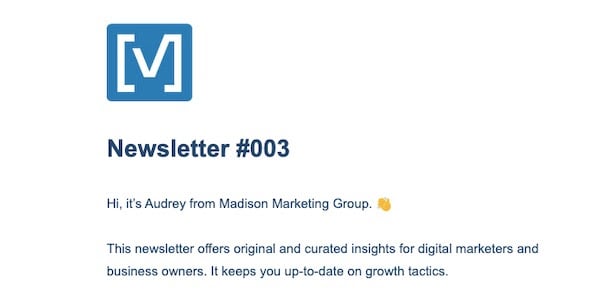
Source: Madison Marketing Group
- Less is more. Ardath Albee (via Dennis Shiao) makes the point that personalization when done badly can be a creepy or gimmicky turn-off, while tactful, limited personalization can be engaging, such as industry-specific personalization.
- Provide helpful personalization, not trivia. Albee recommends B2B businesses focus on personalization that hints at how the business will solve recipients’ problems vs. proving they know the recipient well with trivia and insights.
One way to do this is by 1) knowing about the recipient’s industry and related pain points, then 2) telling a story in the email that relates to these, such as how your company solved the problems of a similar company.
Automate
- Set up autoresponders to ease your workload. If you’re new to email automation, Backlinko recommends starting simple with autoresponder emails.
According to Campaign Monitor, these are automatic replies to people who trip a trigger, such as emailing a particular address or taking a particular action on a website. Get Response elaborates that they can be a sequence of emails that are sent out in a particular order at “regular intervals.” - Try automated follow ups. The Content Marketing Institute notes that many recipients won’t see your first email, so it’s important to follow up for another chance at getting their attention.
- Try full marketing automation. If you’d like to set up emails that can react to your audience’s engagement, marketing automation is a good choice, Get Response says.
Backlinko recommends being careful not to overcomplicate it. Segment your audience into 2 or 3 groups, then use automation to send hyper-targeted personalized messaging that takes into consideration factors like actions they have taken on your site, and data you’ve gathered about them.
One example is the out-of-office autoresponder. Autoresponders can also be used for welcome emails, notifications, and according to Campaign Monitor, are generally helpful in situations where a client initiated a process themselves and expect a prompt response.
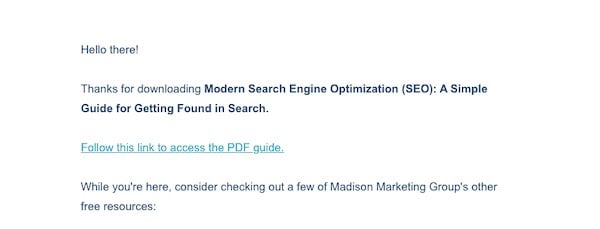
Guide download autoresponder; Source: Madison Marketing Group
Backlinko suggests creating simple sequences, such as welcome email > engagement email > valuable content email 1 > and so on.
Back to Top
7. Time it right
Send emails when recipients are most likely to open them.
Identify the best times to send emails
- Try different times of day. You can find an endless amount of advice online about when to send emails or post on social media, but at the end of the day, it’s different for every business, because your prospects may have different habits. Backlinko recommends experimenting to see what works for you.
- See if the conventional “best” times work. That said, Backlinko notes mid-morning and early afternoon often work. Many read their emails early in the morning, so your email will stand out when their inbox is mostly empty.
Your subscribers' time zones are also important to consider. As a B2B, your goal is to land in subscribers’ inboxes when they’re mostly empty and subscribers are at work.
Find the best frequency
- Email contacts within 24 hours of subscribing. HubSpot recommends striking while the iron’s hot, and notes that your subscribers’ behavior at this stage may help you predict how receptive they will be later.
- Get the frequency just right. As we mentioned earlier, Backlinko advises a frequency of no more than once a week unless you’re running a special promotion. Bottom line: don’t overwhelm subscribers.
Conclusion
While this list may feel a little overwhelming now, keeping some of these tips in mind may help you improve click-through rates, stay out of trouble with spam folders, and make sure that your email safely arrives in your recipients' inbox (hopefully at just the right time.)
If you’re already busy with day-to-day tasks but want to keep a healthy stream of qualified leads coming in, you may be thinking about whether you need to hire in-house help or get an agency to do this work for you.
If this sounds familiar, check out our comparison guide:
Topics: Email Marketing


